'Inflectional Aspects of Adjectives in the Dialects of Dutch-speaking Belgium'
(1980)–J. Taeldeman–
[pagina 223]
| |||||||||||||||||||||||||||||||||||||||||
Inflectional aspects of adjectives in the dialects of Dutch-speaking BelgiumGa naar voetnoot*Johan Taeldeman | |||||||||||||||||||||||||||||||||||||||||
1. IntroductionUntil the very recent past the field of linguistics was characterized by, among other things, a deep mistrust and a general lack of mutual appreciation between ‘dialectologists’ on the one hand, and ‘general linguists’ on the other. It was not until the last few years that a distinct change in attitude on both sides - fortunately - became noticeable. Nowadays only a handful of linguists remain to be convinced of the fact that dialect research is meaningless unless it is placed within the framework of a general theory of language and linguistic change. At the same time, the general process of theory formation can benefit from the findings of dialect research, both monotopical and diatopical. One might indeed justifiably regard every dialect as a natural language (even less subject to stereo-typification than Standard languages). This being true, monotopical studies give far more interesting information for the confirmation or falsification of hypotheses on the grammars of natural languages. Up to now, TG linguists have turned - with surprisingly naive greed - to all kinds of exotic languages to set up these grammars. With regard to the relevance of diatopical studies, the reader is reminded here of the famous maxim of the first German dialectographers: ‘aus dem räichem Nebeneinander ein zeitliches Nacheinander’; in other words: dialects can cast a revealing light on the hows and whys of language change. The purpose of this paper is to illustrate this fruitful interaction of general theory (-formation) and (monotopical and diatopical) dialect research through adjective inflection in the dialects of Dutch-speaking Belgium. At this moment, my research may not yet have led to any detailed alternatives to the general (TG) theory; the fascinating aspect of this | |||||||||||||||||||||||||||||||||||||||||
[pagina 224]
| |||||||||||||||||||||||||||||||||||||||||
limited subject is that it confronts us ‘live’ with the most controversial topics in generative (morpho)phonology: the function of the lexicon (5.1.), the abstractness conditions on underlying representations (4.1, 4.2.), the problem of rule ordering (4.3., 5.3.), simplification of the system by creating a more ‘natural’ rule context as a possible target of linguistic change (3.). After an exploration in general terms of the subject-matter of this paper (section 2.), the inflection of attributive adjectives will be discussed in three stages: masculine singular (section 3.), neuter singular (section 4.), and feminine singular + general plural (section 5.) | |||||||||||||||||||||||||||||||||||||||||
2. Some general remarks on inflectionAs there is no inflection of any kind in Dutch in the predicative use of the adjective, a discussion of inflection in attributively used adjectives will suffice. In this respect one has to distinguish four types: masculine singular (m), feminine singular (f), neuter singular (n), and the plural of the three genders (pl). One can assume the following underlying suffixes for the entire Southern Dutch area:
(1)
Several things are worth noting in this paradigm. (i) As regards the underlying suffixal forms, the most remarkable difference between the North and the South is to be found in the neuter: north of the rivers Rhine and Meuse (the classic ‘Great Divide’ between the Northern and Southern Netherlands) one finds after a definite determiner or pronoun a ə-suffix (alternating with Ø); in the South ə does not occur,Ga naar eind1 for example:
(2)
Historically this difference sterns from the morphological opposition of ‘strong’ (suffix -Ø) vs. ‘weak’ (suffix -ə) inflection.Ga naar eind2 As early as the | |||||||||||||||||||||||||||||||||||||||||
[pagina 225]
| |||||||||||||||||||||||||||||||||||||||||
Middle Dutch period there was a tendency towards the assimilation of the adjective suffix to the preceding pronoun or determiner. This resulted in an extension of strong inflection (to the detriment of its weak counterpart), which at the same time implied a simplification of the system. In Northern Dutch the -ə/-Ø) alternation in the neuter is the only relic of the historical opposition of strong vs. weak inflection; in Southern Dutch this opposition has disappeared altogether.Ga naar eind3 (ii) While the feminine and plural have historically different suffixes, it is, when viewed synchronically, remarkable how the two cases act identically in southern dialects. This in spite of the fact that precisely here one finds both locally and geographically the most subtly conditioned alternations (i.e. ə or Ø). This seems to indicate that the possible change from -ə to Ø cannot be very old historically, and that the (synchronic) change is phonologically rather than morphologically conditioned. This explains the uniform underlying feminine and plural suffix form -ə. Below we shall take a more detailed look at the suffixes of (1) above. | |||||||||||||||||||||||||||||||||||||||||
3. Masculine singular (m)Throughout the Dutch-speaking area one may assume -ənGa naar eind4 as the basic suffix form, cf. een/ne grōt[ən] aap ‘a big monkey’. This also holds true for dialects that have no linking -n between auslaut -ə and the anlaut vowel of the subsequent noun.Ga naar eind5 It would be plausible to expect this suffix form to be pronounced -ə in the ‘classic’ -n apocope areas (roughly speaking Brabant, the south-west excepted, Limburg, and a few scattered areas in Flanders: Ghent, Hulst, Temse and Rupelmonde in the Waasland, and a small area in north-western French FlandersGa naar eind6, and to be pronounced -ən outside the apocope areas. In fact, however, the situation is quite different as Map 1 shows (p. 226). Thus, one finds a uniform -ən/-ə alternation in Antwerp, West-Brabant,Ga naar eind7 eastern Flanders and the major part of western Flanders (i.e. more than two-thirds of the Southern Netherlands). The decisive distributional factor for the choice of either -ə or -ən is formed by the initial segment of the subsequent noun:
For example: | |||||||||||||||||||||||||||||||||||||||||
[pagina 226]
| |||||||||||||||||||||||||||||||||||||||||
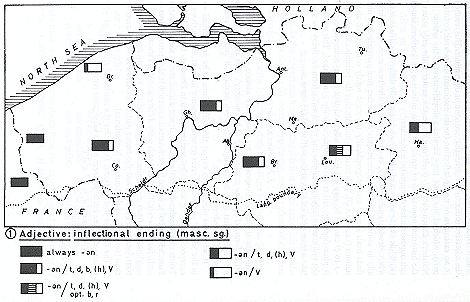 | |||||||||||||||||||||||||||||||||||||||||
[pagina 227]
| |||||||||||||||||||||||||||||||||||||||||
(3)
In view of this a few interesting questions come to mind. (i) What determines the naturalness of the ‘class’ of segments consisting of <t, d, b, h>? For it is exactly this naturalness that might explain the alternation. (ii) Does or does not such an unnatural rule context indicate a (highly unstable) system-in-change? Normally speaking, it would, the more so if one regards simplification of the system (and consequently the rules of that system, too) as one of the aims of language change. However, what does one find? This system shows a remarkable stability, both in space (cf. the large area) and in time!Ga naar eind9 Only in the extreme West and East of the Southern Netherlands do somewhat more natural rule contexts for the -ən/-ə alternation occur: Limburg:Ga naar eind10
the northern coastal area of western Flanders:Ga naar eind11
In French Flanders and the extreme West of Flanders, the alternation does not even exist at all:Ga naar eind12 -ən occurs in all positions. It is at this moment difficult to trace whether these occurrences are simplifications of the Flemish-Brabant rule as regards its context. As far back as a century (cf. Willems' dialect material) the same situation was observed. Synchronically there are no indications as to the expansiveness of these simpler and more natural systems! Generally speaking it is possible to attribute the tenacious survival of the adjectival inflectional -ən (m) to the need for expressing the opposition of this element to (f) -ə. The distinctions between the genders are after all determined in the lexicon. As a consequence, the above example is | |||||||||||||||||||||||||||||||||||||||||
[pagina 228]
| |||||||||||||||||||||||||||||||||||||||||
a supporting argument for the following hypothesis: the fact that a functional opposition or alternation (on a morphophonological level) is lexically determined adds to the consolidation and conservation of that opposition or alternation. | |||||||||||||||||||||||||||||||||||||||||
4. Neuter singular (n)In the neuter singular, the dialects of the Southern Netherlands show no suffix whatsoever. However, this is not to say that the adjective formation is a-suffixal. Below, two morphophonological alternations of the adjectival basic morpheme will be discussed, where the conclusion in both cases will be that the alternation cannot be adequately explained synchronically if one does not posit a zero suffix -Ø for the (n)-form. This, of course, is a very serious step, since it is exactly opposed to the rather basic constraints which have been placed on underlying representations in recent years. For, as such zero suffixes are never realised (directly), what is introduced here is in fact a case of ‘absolute neutralization’.Ga naar eind13 However, this is far from saying, of course, that we would generally opt against an optimally natural representation. | |||||||||||||||||||||||||||||||||||||||||
4.1.In the dialect area in Flanders that has no -ə apocope,Ga naar eind14 one finds several dozens monomorphematic adjectives ending in -ə, for example dikke ‘fat’, dunne ‘thin’, trage ‘slow’, diepe ‘deep’, verre ‘distant’. Normally one would expect, in attributive use of these adjectives, the following paradigm:
(4)
However, in fact (n) has a form without -ə: for example, een dik stro ‘a thick straw’, een ver land ‘a distant land’. So in this case ‘flection’ occurs together with apocope of stem -ə! The occurrence of this phenomenon is far from isolated, cf. | |||||||||||||||||||||||||||||||||||||||||
[pagina 229]
| |||||||||||||||||||||||||||||||||||||||||
(5)
Apparently in all three cases the following (morphophonological) TRUNCATION rule operates:
(6) auslaut -ə → Ø / - + suffix
The apocope of -ə in (n) adjectives (cf. hij is dikke ‘he is fat’, but een dik paard ‘a fat horse’) can only be explained, and integrated into the theory by means of rule (6). However, this implies the introduction of a zero suffix. Any other way it would become a purely lexical matter which it evidently is not. Apart form all this, there is a supplementary functional explanation of the apocope of -ə in (n) adjectives: apocope is the primary means to express the (lexical) difference in gender of (f) and (n), cf. een dik+ə koe ‘a fat cow’ vs. een dik+Ø paard ‘a fat horse’. | |||||||||||||||||||||||||||||||||||||||||
4.2.Especially in Flanders and (roughly) the northern half of Antwerp (see Map 2 p. 230), the adjectives with underlying V̄ + d/ (e.g. kwaad ‘angry’, rood ‘red’, dood ‘dead’, oud ‘old’, koud ‘cold’)Ga naar eind15 show a remarkable alternation: used predicatively (without a suffix) they end in -[t] (by final devoicing of /d/); used attributively in neuter singular (with no realized suffix) they end in V̄ or V̄ + j/w. For example:
(7)
This seems to indicate a rule of the following type:
(8)  Historically the final -d modifications in (n) adjectives (e.g. doof(j) = dood ‘dead’) might be explained by analogy with other inflectional forms such as (m) doo(j)ən and (f) + (pl) doo(j)ə, or even as a reflex of a former presence of -ə (i.e. from weak inflection) but, if viewed synchronically, it seems that we are dealing here with the same process as in other inflectional categories in basic morphemes ending in V̄ + d, cf. laa(j)ən (<laaden ‘to load’), roo(j)ər (<rooder ‘redder’), doo(j)ə (<doode ‘dead’). In other words: d→; Ø or j/w after a long vowel and before a suffix that is not con- | |||||||||||||||||||||||||||||||||||||||||
[pagina 230]
| |||||||||||||||||||||||||||||||||||||||||
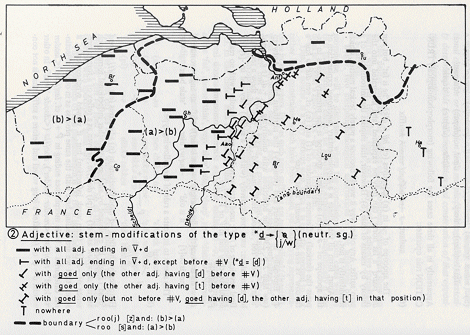 | |||||||||||||||||||||||||||||||||||||||||
[pagina 231]
| |||||||||||||||||||||||||||||||||||||||||
sonantal, especially in anlaut position. This in its turn implies that a zero suffixGa naar eind16 is posited for (n) adjectives, for instance:
(9) /# ād + Ø # bīr #/ becomes:
[a.w bi:r] = oud bier ‘stale beer’ Above we have made an attempt to situate the -d modifications geographically. They were called (roughly speaking) Flemish and northern Brabantish;Ga naar eind17 in the more southern regions of Brabant and the eastern Flemish Dender district, only the adjective goed ‘good’ shows a more or less analogous alternation (cf. [gu: bi:r] = goed bier ‘good beer’). However, one should bear in mind that in this area goed even in predicative use can have a d-less form (e.g. dat bier is goe/goed ‘that beer is good’). As far as -d modification is concerned, in Flanders itself a distinction will have to be made between:Ga naar eind18 (a) the Waasland and a vertical (North-South) strip west of the river Dender:
/V̄____+ Ø#C... cf. rood zand ‘red sand’ becomes roo[s]and next to: een roo[d]èm ‘a red shirt’
(b) otherwise in Flanders:
/V̄___ + Ø#... cf. roo(j) zand next to: een roo(j) èmde
Thus, one can speak in a way of a ‘Staffellandschaft’. | |||||||||||||||||||||||||||||||||||||||||
4.3.The alternation discussed in the previous section is not only interesting with regard to the abstractness controversy (or, more accurately, the reality of a zero suffix). It also touches, and rather spectacularly so, on the discussion concerning rile ordering.Ga naar eind19 In Flemish, generally speaking the following two rules can apply to sequences such as /#rōd + Ø#zănd#/‘red sand’. (i) The well-known devoicing rule operating on fricatives:
(10) [-son][+cont] → [-voice] / [-son] _ | |||||||||||||||||||||||||||||||||||||||||
[pagina 232]
| |||||||||||||||||||||||||||||||||||||||||
cf. rood [s]and
and (ii) the rule of D-DELETION discussed above:
(11) d → Ø/ V̄ _ + Ø# cf. rooø zand
It is worth noting here that the (10) > (11) order is counterbleeding. Now what do the current propositionsGa naar eind20 with regard to intrinsic rule ordering predict? They predict either simultaneous application of both rules, or application in the order (10) > (11), which in both cases renders roo [s]and!! What in fact happens, however, is that the vast Flemish area falls apart in two sections (cf. Map 2). French Flanders and the larger part of western Flanders show roo [z]and, goe [v]olk ‘good folks’, etc., but elsewhere the more plausible roo [s]and, goe [f]olk, etc. are found. This opposition is easily explained if one considers it to be the result of two different application orders of rules (10) and (11):
(12) /#rōd + Ø#zănd#/
These facts appear to be incompatible with any theory of purely (or entirely) intrinsic rule ordering. It is, however, possible via Koutsoudas' (1976) hypothesis of simultaneous rule application to predict that the eastern area (with roo [s]and as the result of the simultaneous application of rules (10) and (11)) is expansive to the detriment of the western area with its ‘unnatural’ rule order (11) > (10). | |||||||||||||||||||||||||||||||||||||||||
5. Feminine singular (f) and general plural (p)It seems reasonable to posit a basic suffixal form /ə/ in the entire area of the Southern Netherlands. On the systematic phonetic level, however, this area is to be regarded as a ‘Staffellandschaft’, in that the suffixal -ə is reduced more and more towards the East. Grosso modo one can distinguish three main areas,Ga naar eind21 as displayed in Map 3. (i) Flanders (with the exception of the Dender district);Ga naar eind22 Here, suffixal | |||||||||||||||||||||||||||||||||||||||||
[pagina 233]
| |||||||||||||||||||||||||||||||||||||||||
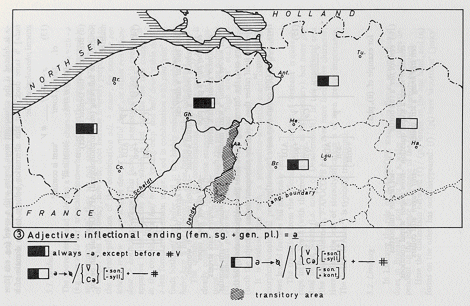 | |||||||||||||||||||||||||||||||||||||||||
[pagina 234]
| |||||||||||||||||||||||||||||||||||||||||
-ə is deleted if the subsequent noun begins with vowel (e.g. een [tεm ində] ‘a tame duck’) but this alternation belongs to the domain of a general phonological rule:
(13) ə → Ø/ _ # V
(ii) Brabant (+ the Dender district):Ga naar eind23 Roughly, the following (morphophonological) APOCOPE rule can be formulated:
(14) 
In any case, the determining factor is the phonological make-up of the adjective itself rather than that of the subsequent noun. (iii) Limburg:Ga naar eind24 Here, ə--APOCOPE occurs even more frequently:
(15) 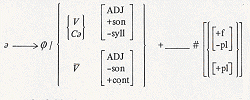 for example cf. (ii), plus:
(16)
| |||||||||||||||||||||||||||||||||||||||||
[pagina 235]
| |||||||||||||||||||||||||||||||||||||||||
In the case of Brabant and Limburg, this rather rough sketch needs elaboration in a number of ways. | |||||||||||||||||||||||||||||||||||||||||
5.1. BrabantThe abovementioned rule has a facultative character in that forms with -ə (e.g. een vuilə kat) are scaled somewhere between the extremes ‘impossible’ and ‘common usage’; they are not sanctioned but have a low frequency of usage. This frequency, however, does increase inversely proportional to the stereotypification of the combination adj. + noun, for example een schoon vrouw > een schoon deur ‘a beautiful door’, or rather een schone deur > een schone vrouw. This factor of ‘stereotypification’ is even more apparent in the adjective half, which is just outside the rule context:Ga naar eind25 in the combinations half maan ‘ceiling-mop’ and half deur ‘stable door’, ə-less forms are common usage. Used in combination with pint ‘pint’, one finds both half and halve, and in the highly coincidental combination een halve kast ‘a half cupboard’, ə-less forms are all but non-existent. The common usage of the combinations half deur and half maan is clearly connected with the extreme stereotypification of these combinations. They are even halfway through the process of becoming compounds (cf. standard groenvink ‘green finch’, hoogstraat ‘high street’, etc.). Prosodically, however, they still follow the pattern of substantive groups (both the adjective and the noun carry primary stress). It is evident that such a pragmatico-semantic conditioning of the morphophonological process is hard to integrate into a formal grammar: even lexical features fail miserably here! The transition from the ‘Flemish’ area to that of ‘Brabant’ is quite abrupt in the North (with the river Scheldt as its boundary), but more gradual in the South (i.e. south of Dendermondt). In this transitional area (the Dender district), ə-APOCOPE has an even more facultative character. Here, also, the role of stereotypification is of even greater importance. The dialect of AalstGa naar eind26 is typically transitional. | |||||||||||||||||||||||||||||||||||||||||
5.2. LimburgIn Limburg the rule of ə-APOCOPE stands on firmer ground than it does in Brabant. It not only has a wider rule context; it is also less dependent on the presence or absence of the factor of stereotypification. Here the distinction between (f) / (pl) forms on the one hand, and (n) forms on the other has not disappeared: (f) / (pl) have ‘stoottoon’ (‘jerky’ | |||||||||||||||||||||||||||||||||||||||||
[pagina 236]
| |||||||||||||||||||||||||||||||||||||||||
pronunciation), whereas (n) forms have ‘sleeptoon’ (‘slurred’ pronunciation).Ga naar eind27 For example:Ga naar eind28
(17)
This opposition of tones simultaneously explains why morphophonological ə-APOCOPE is so firmly established in Limburg: it has a functional explanation. | |||||||||||||||||||||||||||||||||||||||||
5.3.Generally speaking, in the recent literature on the (internal) applicational order of morphophonologically and phonologically conditioned rules, the prevailing view is that the former usually apply before the latter. Some linguists (a.o. Goyvaerts (1975)) do not even hesitate to call this a binding principle. In order to find out how all this relates to the Brabant/Limburg rule of ə-APOCOPE, it is necessary to compare this rule with a number of Brabant/Limburg phonological rules. (i) In a relatively large area of southern Brabant (see Map 4 below), the following phonological rules apply to underlying ā + w:
(18) w → v/ā _ (+)ə SPIRANTIZATION
(19) w → Ø/ā _ # W-DELETION
From alternations such as ne(n) [fla:və] (m.) - (een) [fla:] (f) + (pl), one may infer that the rule of ə-APOCOPE does indeed apply before both (18) and (19),Ga naar eind29 thereby confirming the current hypothesis. (ii) Yet, there are more examples of low-level phonological rules that must precede the APOCOPE rule in such a way that they are in a feeding relation, cf.: | |||||||||||||||||||||||||||||||||||||||||
[pagina 237]
| |||||||||||||||||||||||||||||||||||||||||
 | |||||||||||||||||||||||||||||||||||||||||
[pagina 238]
| |||||||||||||||||||||||||||||||||||||||||
(a) the epenthesis rule introducing the so-called svarabhakti-vowel between a postvocalic liquid and a non-coronal consonantal segment, e.g. [kaləm] =kalm ‘calm’, [wε.rəm] =warm ‘warm’, [ε.rəm] -arm ‘poor’, cf. the rule context for ə-APOCOPE in Brabant and Limburg. The derivational chain of warme (f) + (pl) thus becomes: wεrm+ə → wεrəmə → wεrəm
(b) The rule deleting d between postvocalic N or LGa naar eind30 and (suffixal) ə (e.g. rŏnd+ə → rŏnə =ronde ‘round’, wIld+ə →wIlə =wilde ‘wild’, which in Limburg adapts these adjectives for ə-DELETION in (f) and (pl): rŏnd+ə → rŏnə → rŏn, e.g.
vs.
(c) The rule deleting g between postvocalic η and suffixal ə,Ga naar eind31 e.g. lāηg+ə → lāηə ‘long’, which in Limburg adapts these adjectives for the input of ə-APOCOPE: lāηg+ə → lāηə → lāη.
vs.
(iii) With a view to rule ordering, however, the most surprising element was found in Colinet's highly accurate study of the dialect of Aalst (1896). On p. 125 he emphatically notes that the well-known rule of n-ASSIMILATION:
(20) n → [αlab][βcor][γback] / - [C][αlab][βcor][γback]
does not apply to the -n in auslaut after application of ə-APOCOPE. Thus: | |||||||||||||||||||||||||||||||||||||||||
[pagina 239]
| |||||||||||||||||||||||||||||||||||||||||
(21) 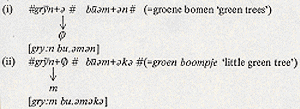 And similarly:
een [sχuən vra:] =een schone vrouw ‘a beautiful woman’ vs. een [sχu.əm vεn̥t̥n̥]=een schoon ventje ‘a beautiful lad’
A scrutiny of several Brabant dialects rendered roughly the same results, which is all the more surprising since one's intuitive idea of-n assimilation (in Dutch dialects and perhaps even universally) is that it must be very low-level and obligatory.Ga naar eind32 With respect to this, the question crops up of how all this can be accounted for in a generative-phonological description of these dialects. Those who adhere to the (over)powerful means of a strictly linear extrinsic rule ordering might be able to save their case formally by having the assimilation rule operate before the (morphophonological) apocope rule. Those who opt (and rightly so) for intrinsic rule ordering according to a limited number of universal principles will benefit poorly from the current proposals. For a correct understanding of this matter, the major relevant proposals are summarized under three headings:
(i) Kiparsky (1968a, 1971, 1973) 1968a: ‘Rules tend to shift into the order which allows their fullest utilization in the grammar.’ 1971: ‘Rules tend to be ordered so as to become maximally transparent.’, where: a rule (P) A → B/C - D is ‘opaque’ (reverse: ‘transparent’) in that one still finds systematic-phonetic forms of the type: (i) A in the context C - D (ii) B in a context different from C - D (iii) B which is not the result of process (P) (e.g. underlying) in the context C - D (ii) Kisseberth (1972a, 1972b, 1973) | |||||||||||||||||||||||||||||||||||||||||
[pagina 240]
| |||||||||||||||||||||||||||||||||||||||||
(P1) ‘Whenever possible, a rule Ri is applied in the sequence that will leave no surface structures that satisfy the structural description of Ri;’ (P2) ‘Ri is not applied if there exists some other rule Rj whose subsequent application destroys the structural configuration that induces Ri.’ (iii) Koutsoudas-Sanders-Noll (1974): ‘The natural situation for a rule is to apply (possibly simultaneously with other rules) wherever its structural description is met.’ With mutually bleeding order the principle of ‘proper inclusion precedence’ (PIP) holds: ‘For any representation R, which meets the structural description of each of two rules A and B, A takes applicational precedence over B with respect to R if and only if the structural description of A properly includes the structural description of B.’ We shall confront our (Southern) Dutch assimilation rule and the Brabant/Limburg rule of ə-APOCOPE with each of the above proposals. ad (i): The order assimilation > apocope (cf. above) is counterfeeding, and therefore unnatural (Kiparsky 1968a). Moreover the assimilation rule is ‘opaque’ in that one finds forms with un-assimilated -n (Kiparsky 1971, principle (i)). ad (ii): The Brabant situation is a blatent violation of (P1) if one takes the assimilation rule as Ri. ad (iii): Application of the rules, when their structural descriptions are met leads to an observationally inadequate grammar. In order to save the principle of intrinsic rule ordering, one might theoretically consider lexical marking of the adjectives ending in V̄ + n (bruin ‘brown’, schuin ‘slanted’, groen ‘green’, klein ‘small’, fijn ‘fine’, etc.) as exceptions to the assimilation rule. There is a snag, however, in that these adjectives are exceptions in (f) and (pl), but not in (n),
Therefore one would have to lexically mark the inflectional forms (f) and (pl) rather than the morphemes as such, which as far as we can see is quite impossible. If in our description we wish to preserve the status of the assimilation rule we have intuitively attributed to it (i.e. a low-level P-rule), there appears to be as yet only one solution: an appeal to the | |||||||||||||||||||||||||||||||||||||||||
[pagina 241]
| |||||||||||||||||||||||||||||||||||||||||
notion of global constraint.Ga naar eind33 In that case, the assimilation rule is formulated as follows:
(201) n → [αlab][beta;cor][γback]/ _ {+}{#} [C][αlab][βcor][γback]
Condition: the input -n has not become word-final through application of ə-APOCOPE.Ga naar eind34
The only somewhat unelegant aspect of this solution is that which can be held against ‘global constraints’ at all times: it represents a tremendous addition to the power of grammars. | |||||||||||||||||||||||||||||||||||||||||
6.As was said in the introductory section of this paper, the main purpose of this contribution was to give an illustration of the fruitful interaction that can and must exist between the general theory and (monotopical and diatopical) dialect study. The section on adjective inflection in the dialects of the Southern Netherlands has confronted us intensively with the most controversial topics of generative (morpho)phonology; again, and in many ways, the concrete analysis of the facts has proved to be a true challenge to the theory. | |||||||||||||||||||||||||||||||||||||||||
[pagina 243]
| |||||||||||||||||||||||||||||||||||||||||
References
| |||||||||||||||||||||||||||||||||||||||||
[pagina 244]
| |||||||||||||||||||||||||||||||||||||||||
| |||||||||||||||||||||||||||||||||||||||||
[pagina 245]
| |||||||||||||||||||||||||||||||||||||||||
|
|

